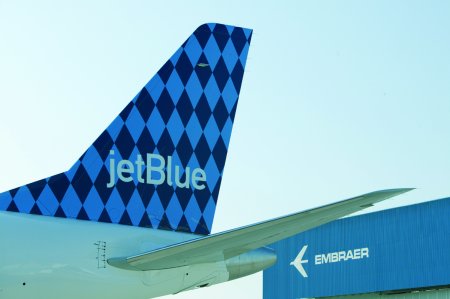US majors will soon come under pressure from JetBlue Airways on some of their thinner routes, as the carrier introduces its upscale, low-fare service on its new Embraer 190s.

During November JetBlue started phasing in flights with new 100-seat Embraer 190s on short- and medium-haul routes that mainline carriers have generally given to regional partners to fly with their cramped and increasingly unpopular 37- and 50-seat regional jets.
The comparison will not be pretty. The 190 is definitely not a regional jet. JetBlue officials have joked about how passengers may find they prefer the 100-seater over its also-growing fleet of 156-seat Airbus A320s.
Not even 1.5m (5ft) shorter than the A320, JetBlue’s 190s have wider, two-by-two leather seats – and no middle seats – with 32-33in (81-84cm) pitch, wider aisles, larger individual video screens with 36 channels of free DirectTV programming, 100 channels of XM Satellite radio, and spacious under-seat storage.
JetBlue received the first four of its 190s in early November, and began high-frequency flights between its New York JFK base and Boston Logan. The two airports are served now by American and Delta regionals, which operate small regional jets, although the Delta and US Airways long-established shuttles between the two cities, serving New York LaGuardia, are also competing in this market.
JetBlue’s route plan for the 190s was eagerly awaited. Over the next five months, it will phase in the 190s on new routes from Boston to Richmond, Virginia; Austin, Texas; West Palm Beach, Florida, and Nassau, Bahamas. From JFK, it will use the 190 to start new routes to Richmond and Austin and to increase frequencies to Burlington, in Vermont, and Buffalo, in New York.
Jetblue officials say they will start 190 services close to home and then branch out. The aircraft makes it possible to serve about 891 new mid-sized markets, three times the number of A320 markets, says the carrier’s chief operating officer Dave Barger. He says: “100 seats seems to be the sweet spot.”
JetBlue chief executive David Neeleman says the break-even load factor on the 190 will be 65-70%, depending on average fares and oil prices, but adds that JetBlue will be able to raise prices to cover the rising costs of fuel because it will be in markets where others have been charging much higher fares than on its A320 routes.
He says: “We’ll have a lot less competition in the markets we’ll be flying to. There will be a lot of markets where we will compete with 50-seaters.”
JetBlue will have eight 190s in service by the end of the year and will take 18 more a year through 2011. The carrier will also have 85 A320s flying by year-end and will add 16 more of the Airbus narrowbodies next year.
CAROLE SHIFRIN/SAO JOSE DOS CAMPOS BRAZIL
Source: Airline Business























